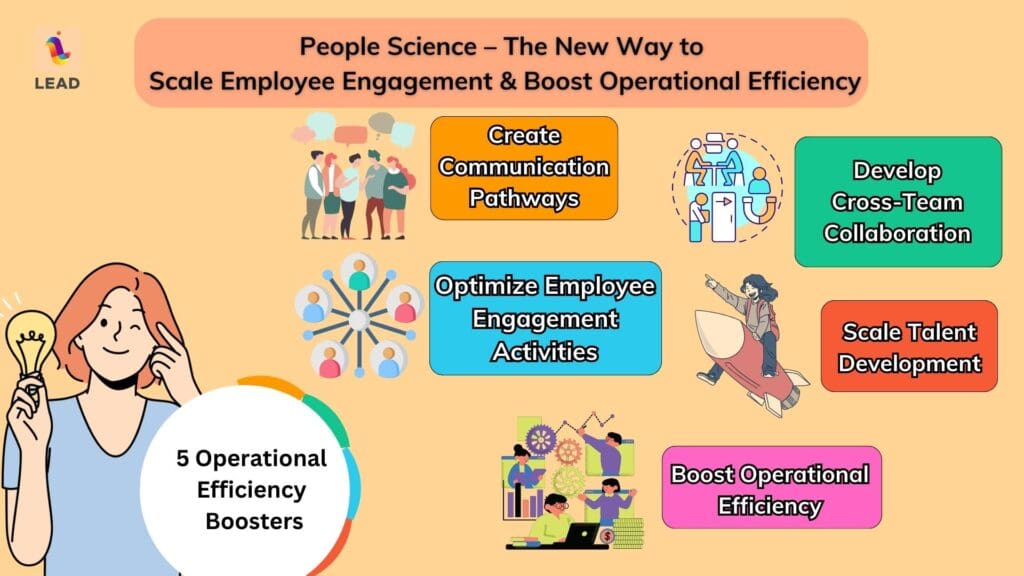Workforce management to maintain good operational efficiency is a daunting task for any business. Ever since the birth of modern industry, managing your workforce has been a top priority for businesses. Earlier it was all about good working hours, office amenities, and the PF. Things are far more complicated now especially considering the global remote working scenario.
We know that remote work is here to stay, even if the rising call for RTO mounts up around the world. Meanwhile, managers are under a lot of pressure to deliver results and fear remote work may harm their operational efficiency. You have to feel bad for mid-line managers in this. They’re stranded in the deep end of the pool without a paddle on this one. But not really. Not if you use people science to bolster your HR tech and workforce management policies.
Want to get the gist in short? Find the biggest details here in 60 secs or less. Don’t forget to sub to our Youtube channel for more insights!
What is People Science?
People science is the methodical and metricized approach to understanding how organizations and their people work together. For this, it combines behavioral psychology, organizational development, business analytics, data science, etc.
In particular, the growth of Organizational Network Analytics (ONA) leverages a brand new way to grow the human-level understanding of workforce insights. Rather than using traditional people science that analyses hierarchical models of a business, ONA uses dynamic interaction models to deliver workforce insight. This means businesses get better leads on how their people are talking to each other.
As this Business Insider article explains,
Depending on an organization’s development stage and business model, people analytics can provide a range of value. CHROs, therefore, need to consider different use cases depending on who they are and where they want to go.
From this, they can generate insights on how to develop workforce talent, increase employee retention, and boost operational efficiency via productivity increase. Moreover, they can identify superconnectors and mid-line changemakers who drive business performance between the hard hierarchical lines of any business.
People Science – The New Way to Scale Employee Engagement & Boost Operational Efficiency
Creating Communication Pathways
Key Takeaways:
-
ONA-based People Science enables the identification of organic communication pathways.
-
These insights help managers break down siloed thinking and foster innovation.
-
Organic communication also helps add value to CX processes through info value addition.
One of the biggest problems with hierarchical communication is that it is not enough to run teams effectively. Moreover, with companies now handling more remote workers than ever, there is a need to understand informal communication channels more than ever. This defines not only how people collaborate but also how managers can use channels to develop better team collaboration standards. This further helps in implementing crucial micro-team strategies like the buddy system and AI-supported mentorships.
Moreover, using organic communication channels also enables converting good employee experiences to good customer experiences. This is a vital factor for creating a brand story experience that delivers unique client experiences. The most successful companies in the world do not base their client retention stats on numbers but on feelings. A good example is Apple which, admitted hasn’t the best-featured phone in the market. However, the combination of its products enables it to deliver an experience par excellence. Using ONA insights enables managers to understand how to create a direct EX to CX brand story experience and make clients a direct part of it.

People Science – The New Way to Scale Employee Engagement & Boost Operational Efficiency
Developing Cross-Team Collaboration
Key Takeaways:
-
People science helps create better interdepartmental collaboration and boost performance.
-
It enables more dynamic mentorship and career development opportunities.
-
HR managers can scout for liaising talent and people who can work in multiple departments.
People science works best in ONA formats since it looks into how people actually talk and work with each other. Leveraging individual relations over formal hierarchies helps managers integrate teams better, particularly ones that include remote interns and hybrid workers. Such setups require cross-team collaboration using tools like Slack and MS Teams. Lining up employee engagement activities along with these is a good idea since they streamline both work and collaboration together. As this McKinsey blog explains,
Leaders at many organizations acknowledge that what they call their “analytics” is really basic reporting with little lasting impact. For example, a majority of North American CEOs indicated in a poll that their organizations lack the ability to embed data analytics in day-to-day HR processes consistently and to use analytics’ predictive power to propel better decision-making.
Using team collaboration and employee engagement as leverage for dynamic working boosts performance. Remote employees benefit from this especially since they get to collaborate better with colleagues. Further, companies get to understand whom they can trust with crucial micro-tasks. This enables better understanding and collaboration across teams, even global ones. Over time, using ONA enables HR to develop a better career growth and talent succession path, particularly with those who can liaise better between departments.
Optimizing Employee Engagement Activities
Key Takeaways:
-
Effective employee engagement activities depend on creating nuanced campaigns.
-
Understanding communication preferences and social hierarchy enables better campaign development.
-
This is particularly useful for global teams that include people from diverse cultures.
Employee engagement has been the number 1 priority for managers for the past year or two. But despite the growing acknowledgment of what it helps with, there is little success that often comes from it. Engaging with remote employees as a separate process from the actual work process is a mistake. Organic communication channels also offer much more than any artificially contrived program filled with employee engagement activities can.
This is where organizational network analytics help define the direction of employee engagement activities for businesses. They help managers discover and tap into the potential for organic interactions among teams. Since remote teams use digital channels, making good on them is vital. It also helps in developing specialty among teams and may enable team subdivisions and process specialization.

People Science and Analytics and How They Help Increase Operational Efficiency
Scaling Talent Development
Key Takeaways:
-
Identifying superconnectors like mid-line changemakers and quiet contributors is crucial.
-
Managers get to use ONA data to grow talent interdepartmentally and support succession planning.
-
ONA may also help identify isolated and toxic employees, especially in remote settings, and bolster team performance.
Talent development processes are unreliable at best when considered within the context of organizational cultures. Oftentimes, those who are promoted to managerial levels of authority do not enjoy popular support. This causes rifts in the team culture and process and drops operational efficiency. Obviously, this is a problem and this is one of the biggest advantages that people since here to offer. Using organizational network analytics, HR executives realize the true drivers and motivators behind any team’s performance. They create the ideal competitive work scenarios in light of that and this showcases leadership abilities organically. As this Forbes article explains,
If they thrive on interacting with customers, do your best to build client interactions into their role. Or if they are energized by analytical work, give them assignments that emphasize their skills. You won’t always be able to make perfect matches between what people want to do and what they have to do, but when you can find as much overlap as possible, it contributes to thriving through great performance.
Mid-line changemakers who enjoy a lot of peer support deserve to get promotions and move up. However, they often pass self-promotion for just work and this has them getting overlooked. People analytics helps in creating the ideal work environment where changemakers and even quiet contributors may showcase their ability to head the team. Naturally, this makes for far better collaboration and completion all of which feed directly into increasing operational efficiency.
Boosting Operational Efficiency
Key Takeaways:
-
ONA helps scale operational efficiency by providing essential workforce insights to HR execs.
-
Creating lean and effective communication and collaboration fosters multi-vertical growth.
-
This combines the benefits of enhanced team performance, operational efficiency & employee retention.
Lean communication channels follow organic interaction paths. They leverage social capital and also reveal internal politics and team dynamics. Companies use organizational network analytics to develop a better understanding of how their teams operate. This helps them develop a multi-vertical growth plan, bringing in mentorship and new hire onboarding plans that actually work. Companies that do this see better new hire retention rates and also more engagement from older employees. The cumulative benefit here is greater team performance, operational efficiency, and employee retention.
Are You Ready to Leverage People Science to Boost Your Operational Efficiency?
Developing operational efficie4ncy is crucial for ensuring he future of your business. But it requires looking beyond the EPI and FTE metrics your HR does. Using people analytics to make employee engagement activities that genuinely foster cross-team collaboration is the best way to go about boosting business performance. This is where employee engagement, knowledge sharing and team collaboration development apps like LEAD bot offer an unmistakable advantage!
LEAD bot is a team engagement platform for big businesses and MNCs on Slack and Teams. It is an all-in-one team development software with features like virtual coffee chats, buddy programs, birthday celebrations & work anniversary celebrations, new hire onboarding programs, and Pulse Surveys.
LEAD bot also offers cutting-edge Organizational Network Analysis (ONA) for large-scale organizations.
C-suite execs and mid-level managers benefit greatly in their decision-making from ONA and use its highly actionable insights for building strong connections across their workforce. This enables far more forward-leaning talent development and generates greater organizational interconnectedness! Foster better organizational health, talent development, employee retention, and overall performance with this simple app!
LEAD.bot is a product of LEAD.app and we also LEAD.bot’s sister app Sunrize which showcases workplace attendance by graphs right on Slack! Book a demo now!







